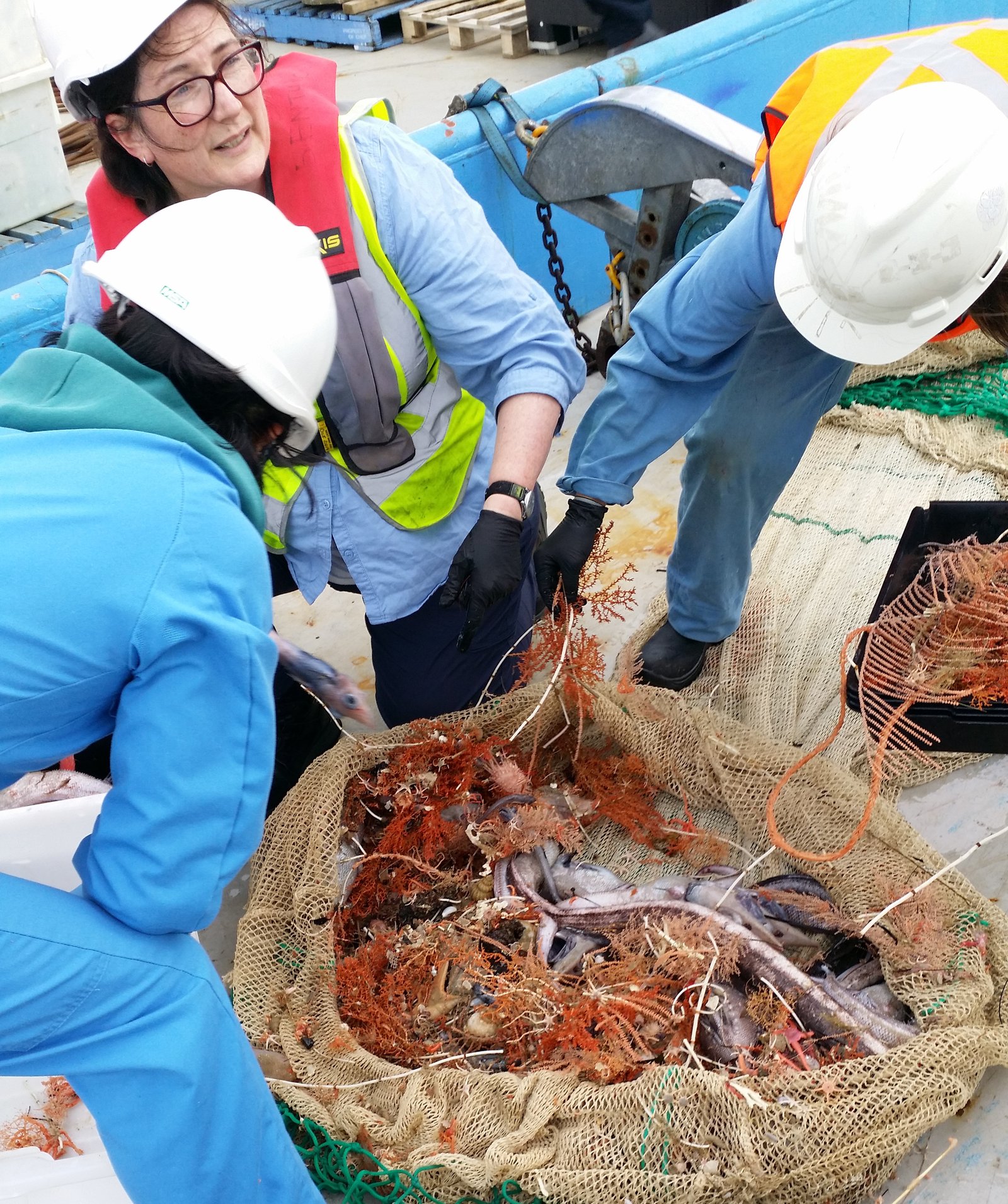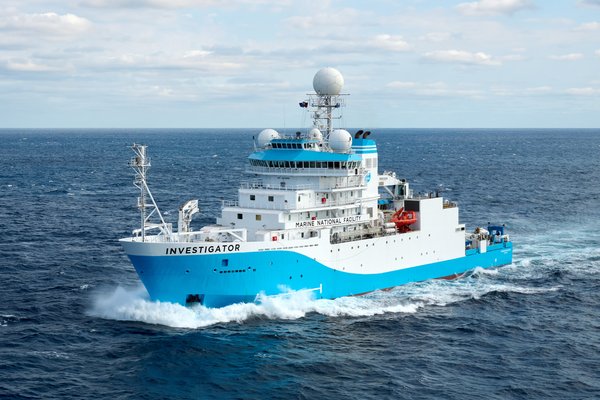Exploring the Deep-sea Life Living on Underwater Mountains
Four scientists from the Australian Museum Research Institute joined a team of researchers from around Australasia on an expedition to explore the deep-sea marine life inhabiting seamounts south of Tasmania.

A first look at new deep-sea critters (with AM’s Alison Miller)
Image: Ingo Burghardt© CSIRO
Seamounts are underwater extinct volcanoes, and more than 100 of these impressive features can be found south of Tasmania at depths of around 1000-2000m. Their hard surfaces and exposure to water currents laden with food particles makes them an ideal environment for cold-water corals. ‘Seamount Corals Survey 2018’ lead by CSIRO and Parks Australia on board the Marine National Facility's RV Investigator was a month-long research voyage to map cold-water corals and their associated marine life on Tasmanian seamounts.

A group of ship’s crew and scientists (including the AM’s Alison Miller and Ingo Burghardt) waiting for the new trawl to come up from the deep.
Image: Dave Logan© CSIRO
The abundant marine life of the Tasmanian seamounts and their history of fishing and protection, made this seamount corals survey relevant not only to Australian Marine Parks, but to researchers and managers of deep-sea marine biodiversity worldwide.

Marine National Facility's RV Investigator docked at Hobart.
Image: Ingo Burghardt© Australian Museum
Deep-sea coral communities are vulnerable to direct impacts from fishing, oil and gas development and mining, and to climate change. These corals grow very slowly, yet little is known about their capacity to recover from damage. Some sections of individual Tasmanian seamounts that held the deep-sea fish, orange roughy (Hoplostethus atlanticus), were repeatedly trawled, removing the coral communities under the fishing tracks.

Simon Grove (Tasmanian Museum and Art Gallery) and Ingo Burghardt (AM) searching for molluscs, polychaete worms and crustaceans in soft corals.
Image: Dave Logan© CSIRO
The main focus of this expedition was to compare the biodiversity of still fished, previously fished and never fished seamounts in order to better understand how these slow-growing communities recover. In order to compare and document the targeted areas, there was a strong emphasis on video transects with the help of a flying deep-tow camera system (see image below).

The deep-tow camera system coming back from the deep sea.
Image: Ingo Burghardt© CSIRO
To compliment the video transects, our task as members of the biological processing team was to additionally assess the diversity of seafloor animals by working on material that was collected by a beam trawl in various locations and depths (see image below).

A selection of our deep-sea catch.
Image: Ingo Burghardt© CSIRO
Living on and among the corals was a wide diversity of organisms, worms, brittle stars, lobsters, hermit crabs, sea urchins and molluscs. These organisms use the coral as a surface to attach to and for protection. The scale worms (worms with small scales attached to their backs) were very abundant on octocorals, it was fascinating to observe how coral fronds had grown around the worms forming protective tubes (see image below and Laetitia’s blog)

Deep-sea polychaete worms found living on soft corals.
Image: Ingo Burghardt© CSIRO
Life at sea on a research expedition is very exciting, however, it can be mentally and physically demanding. You are away from home, miles from land, sharing a cabin with someone you may have never met before, limited internet access, no phone signal, no alcohol, twelve-hour shifts (2am- 2pm or 2pm -2am) seven days a week and seasickness… On departing from Hobart we encountered a strong head wind, most people on board developed signs of sickness (I certainly did! (Laetitia)) and no amount of ‘Kwells’ or ginger biscuits can help. Despite this, the excitement of a trawl being hauled up on deck with a fresh catch of marine life, live underwater images of the deep sea, whale, dolphin and seabird sightings, friendly people and beautiful sunsets and sunrises puts it all in perspective.

Laetitia Gunton (AM), Ricky-Lee Erickson (MV), Francesco Criscione (AM), Alexandra Weber (MV). AM: Australian Museum, MV: Museums Victoria.
Image: Bethany Green© CSIRO
Tasmanian seamounts and the plethora of marine life that lives on these features of are of global significance. Understanding the recovery of corals and associated organisms after deep-sea fishing, oil and gas and mining development is fundamental for the establishment and maintenance of Marine Parks, not only in Australia but worldwide.
Dr Laetitia Gunton: Chadwick Biodiversity Fellow, Marine Invertebrates
Dr Ingo Burghardt: Research Associate/ TO, Marine Invertebrates
More information:
Blogging the Seamounts: Seamount Corals Survey 2018
Ingo’s blog: Discovering the mind-blowing diversity of deep-sea coral reefs
Laetitia’s Blog: Mountains of marine worms find their niche in mountains of corals
The Conversation: Exploring Australia's 'other reefs' south of Tasmania
ABC news: 'Heartbreaking' discovery of human trash 100km off Tasmanian coastline
ABC news: Tasmanian researchers discover new corals in dense 'underwater garden' on ocean mountains
SBS News: 'Extraordinary' undersea world, complete with 100 new species, discovered off Tasmania
Science alert: Look at all these insane deep-sea creatures Scientists just found in Tasmania.












